|
| JOYSTICK JURY
|
|
| What's on your software shopping list for Christmas? Let Ross Holman,
Dave Nicholls and Roger
Willis help you make your mind up!
|
|---|
This month, our motley crew of Joystick
Jurors include Dave Nicholls, a self-
confessed adventure fanatic and seasoned
hacker; Ross Holman, ace games player
and winner of the Jet Set Willy prize; and,
last but by no means least, Roger Willis, a
relative newcomer to the Spectrum scene.
Dave and Ross you'll already know
from our monthly major games reviews.
Roger Willis, on the other hand, is
probably more at home in the saddle of a
massive motorbike ... but that was before
he discovered the thrills and spills of the
Spectrum.
Check out what they thought of the
latest in games software ...
|

|
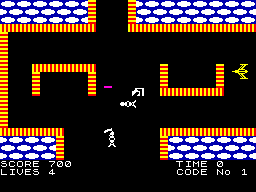
THE PRIZE
Arcade Software / £5.50
|
Dave The Prize is a variation on the maze
theme. You have to control your
spacecraft through the maze, collecting
'code pods' as you go. The pods are
numbered and must be gathered in the
correct order; reaching number five
promotes you to the next level.
Those hitting the fourth level are asked
to find the 'special code', photograph it,
and send the evidence to Arcade Software.
This entitles you to enter the competition
that goes with the game. The competition
has a prize (cunning title isn't it!) of
£5000, but the catch is that the money will
be divided between all the people who
send in correct answers before January
1985.
On the game front The Prize is quite
good, the maze is very large and your ship
moves nice and smoothly. This is,
however, really a game
|
that will appeal
more to cartographers than to
shoot 'em up freaks. 2/5 
Ross A very colourful maze game with a
large prize for the winner. The nasties
aren't that clever, so only the overall size
poses a problem. It loses its
appeal very rapidly. 2/5 
Roger Being quite unable to imagine what
five thousand folding green drink vouchers
will look like stacked next to my keyboard
and as I've never had that much wonga in
my short and miserable life, I find it hard
to imagine this game holding
anybody's interest ... 1/5 
|
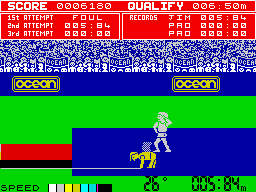
DALEY'S DECATHLON
Ocean / £6.90
Dave Daley's Decathlon is, of course, one
of the several attempts to transfer the
arcade
|
game Track and Field onto the
Spectrum. In fact, it's just about the best
attempt so far. The object of the game (in
case there's anyone out there who doesn't
know!!) is to compete in each of the ten
decathlon events scoring points for speed,
height jumped and so on.
In the running events movement is
accomplished, as usual, by either hitting
two keys alternately or wiggling a joystick
back and forth; a further key is used to
throw or jump in the other events.
Graphically, Decathlon is very good, the
only problem being the rather stiff running
motions of your man. Ocean's logo scrolls
past at the top and a crowd applauds when
you do well. Although there are a few
small bugs (for example, I have it from a
reliable source that it's possible to
|
clear
over 400 metres in the long jump!) the
game simulates all of the events very well,
including an energy limit on the 1500m.
For anyone on the look-out for a Track and Field -type game, this is the
best buy at the moment. 4/5 
Ross Certainly the best track and field
game for the Spectrum, although it doesn't
contain some of the nicer
touches in other versions. 3½/5 
Roger Put a few quid in a deserving
shamateur's pocket. After all, our boy
Daley must've flogged the right to use his
name. Good luck to 'im, too, because
Decathlon earns its keep in screen time
and gave me a lot of much-
needed exercise. 3/5 
|
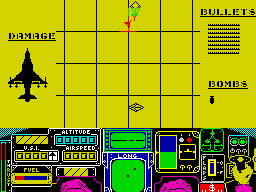
DELTA WING
Creative Sparks / £6.95
Roger This was the one that kept me up at
nights - not that I broke any 'high scores'.
Delta Wing is definitely a game for patient
technocrats.
|
It's based on only two
screens, but these are complicated and
composite. Simulator tendencies are
confirmed by the continuous presence of
cockpit instrumentation across the
bottom. Altitude, air-speed, fuel gauge,
radar and artificial horizon add in to a total
of 14 informative variables to complement
the pilot's hand moving the on-screen
joystick according to player instruction.
All it takes is a tweak of the old
handlebar moustache and there you are,
blasting 'em out of the sky or bombing
their bases. The second screen flashes up
on request and is made up of a map
showing your bases (which can be landed
at for fuel and ammunition), their bases
(which can be bombed), and the current
position of enemy planes (which got me
reciting 'Tally Ho' and 'Wizard Prang'
epithets ...).
A significant attention span and a great
deal of
|
perseverance are vital though,
because in this game nothing comes easily.
Just taking off, involving correct ground
speed related to flap position and timed
pull-back on the joystick, is a thoroughly
skilful operation. Being honest, I could
barely get off the runway
but I felt like an RAF pilot! 4/5 
Ross Slightly simpler controls here than
with other flight games. It's good and fast,
but too similar to existing
products to sell that well. 3/5 
Dave This game drops in somewhere
between the flight simulators and Zzoom.
It's quite playable and easier to fly than
most others of its type. If you want to fly,
but don't want to be able to tell your flaps
from your ailerons then this is
the one for you. 3/5 
|
|
| JOYSTICK JURY
|
|
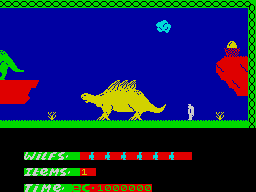
KOKOTONI WILF
Elite / £5.95
Ross Elite has taken the little white man
out of the realm of the superhuman
jumper and more
|
into that of winged
avenger; he's now a decidedly unheavenly-
looking angel! Wilf can be made to move
left, right or flap up the screen; the 'flap'
key repeats so you don't have to wear out
your keyboard.
Kokotoni Wilf is a game of 60 screens
divided into six time zones. To progress
from one to the next, you have to collect a
number of flashing pieces of an amulet -
and then find a time gate. Incidentally, Elite
forgets to mention that you can start in any
of the first three time zones by pressing
keys '1-3' and then you'll find that all the
objects on the previous levels will be
credited to you.
Each screen consists of large fixtures
like trees or dinosaurs (some of which may
animate a little) and smaller, moving
graphics. Tunnels and recesses have
tended to replace the
|
familiar platforms.
The graphics aren't really up to Jet Set Willy
standards and the difficulty I had
controlling Wilf's spritely extravagances
spoiled any appeal
that the game had. 2/5 
Dave This is a reasonable game with above
average graphics, but it gets annoying after
a while because the controls are not
precise enough. Elite advertise this as the
successor to Jet Set Willy. It's
good, but not that good! 3/5 
Roger Maybe 'Flapping Fred' would have
been a better name, or perhaps
'Blundering Budgie', because our hero
Wilf's mishaps can't all be blamed on
Spectrum keyboard insensitivity. Shame
'cos there's enough screens
to last a long time. 3/5 
|
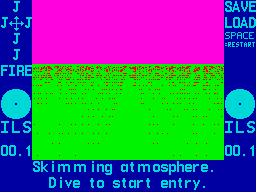
BRAXX BLUFF
Micromega / £6.95
Roger Mission Control, Houston, heaved a
collective sigh of relief the day my careers
master decided I was much too stupid to
|
become a space pilot because - as this
game finally proves - I would have been
very bad at it. Nevertheless, tantrums at
my inability to land the naffin' rescue pod
on the planet Prolon were unavoidable. I
couldn't get past the first three superb
screens in Braxx Bluff ... who knows how
many more I missed!
Moving 3D graphics are 'the biz' right
from the beginning of this rescue mission.
The screens I actually got at involve
descending from the mother ship's orbit
down to skimming the planet's
atmosphere, before diving towards a
landing - the point where you'll need fine
stabilising control to score sufficient points
to achieve a safe descent.
Getting onto the planet and beginning
the search for the three crewmen, trapped
in a stranded hydro-crawler by alien
lifeforms, means acquiring eight points
during 'Lander Phase'. I only managed to
clock a maximum of
|
four and a bit.
All the same, expert space jockeys can
move on to Walker Phase, Land-Crawler
Phases, Sea-Crawler Phases and a finale
where the Commander's 'enigmatic' boat
race appears on-screen to say 'Ta very
much' ... Pass the joystick,
Gladys! 5/5 
Ross Definitely a disappointment after the
last few Micromega games. The 3D effect
is not very awe-inspiring and the supposed
finale is dull. If it didn't have a 'save to
tape' facility, I wouldn't have
played it for very long. 2/5 
Dave The 3D graphics are unconvincing
and the game is quite easy to beat. Even
so, the last stage goes so long that I was
just crashing into rocks on
purpose for excitement! 1/5 
|
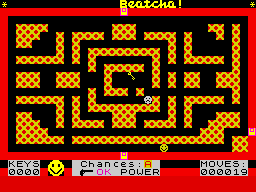
BEATCHA
Romik Software / £6.99
|
Dave At first glance, Beatcha looks a bit
like Gulpman, which was one of the first
Pacman-type games to come out on the
Spectrum. It takes, however, a few more
glances to realise just how similar they
actually are!!
The object of the game is to move
around various 'classrooms' and collect
keys. When all the keys are collected you
have to reach the main door and escape.
Your man is a single cursor 'Smiley' face
which moves at a ridiculous rate and is
chased by unhappy little faces (the
teachers) which in some cases move so fast
that you lose several of your 26 lives
before you can get out of the way. In fact
the game's only redeeming feature is that
there are quite a few classrooms to be
killed in.
|
In short this game is about as much fun
as a three-hour 'partly predictable'
broadcast on behalf of any party you care
to mention. It might make a
useful dustbin filler. 0/5 
Ross This is a standard maze-type game
which proves difficult merely due to the
speed and persistence of the chasers. I
don't think it has much
going for it. 0/5. 
Roger Why did I used to fall asleep at
school? Why does this game remind me of
what fanciful commentators refer to as 'the
best days of my life'? Beatcha, in relation
to teacha(s), is as boring as
the real thing. 1/5

|
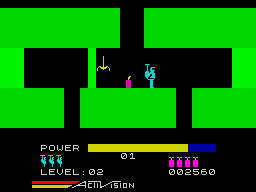
H.E.R.O.
Activision / £7.99
Dave H.E.R.0. is a game in which, as the
name implies, you get to play the hero -
Roderick Hero
|
to be precise. Roderick's
job is to rescue trapped miners caught
when Mount Leone erupted.
To help him he has a miniature
helicopter thing strapped to his back which
allows him to fly up and down the vertical
shafts, a microlaser helmet for shooting
nasties, and several sticks of dynamite
which are capable of 'removing' any thin
walls that happen to get in the way (if
necessary the laser can also be used to
break through walls, but this uses up a lot
of power). As well as having to shoot his
way past spiders, bats and other mine-
dwelling creatures, Roderick also has to
contend with lamps that can be put out by
careless shooting or flying and, in the later
stages, 'molten lava' walls that kill on
contact.
Graphically the game is simple. The
walls are large blocks, and the control of
the backpack
|
leaves a lot to be desired.
But it has got that 'one more time'
addictive quality that keeps you playing
and, because after level 17 the mines are
randomly generated, there's
no way it'll be mastered. 4/5 
Ross The delay on our hero's contraption
makes control tricky - though not to a
detrimental extent. But the plain blocky
graphics for the cave
walls are very dull. 2/5 
Roger Wot is Roderick Hero doing with
this 'rescuing miners' stuff? Doesn't he
know the political consequences? Being an
'all-round Good Guy' does have its
advantages and sleep inducement seems to
be one of them, despite
increasing difficulty. 1/5

|
|
| JOYSTICK JURY
|
|
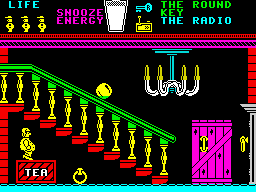
PYJAMARAMA
Mikro-Gen / £6.95
Ross Pyjamarama is the second of Mikro-
Gen's games to feature the infamous
'Wally'. This
|
time, our Wal' is having a
nightmare (He'd dreamt he'd just bought a CBM 64? Ed.) and the only way he's
going to be able to wake himself up is to
find the key to his alarm clock and wind it
into action. The setting for the game is
Wally's home, each screen representing
one room and each filled with beautifully
drawn and coloured furniture. In a way
that's similar to Atic Atac, you guide our
sleeping hero through the rooms - this
time seen from the side; just like Jet Set Willy, you can move left, right or jump.
Only a few screens have things for Wally
to jump on - chairs, tables or staircase.
Each room of Wally's house has a
number of doors. Some can be opened just
by jumping at the handle but to get
through others you need to be carrying
certain 'objects'.
|
You also have a limited amount of
energy per life which decreases each time a
moving graphic hits you ... so watch out
for the hands which burst from the floor
and grab you! Touches like this make
Pyjamarama a humourous
and enjoyable game. 4½/5. 
Dave Mikro-Gen says you'll never dream a
program could be this good, and for once
the advert is right. It's worth
buying for the games room. 5/5 
Roger It's hard to play but easy to watch.
Wally's nightmare won't put you to sleep
- just the opposite. It's both pretty and
pretty funny, err, if you know
what I mean ... 4/5 
|
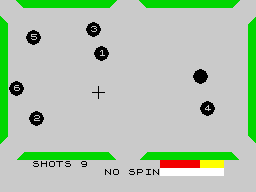
HUSTLER
Bubble Bus / £6.99
Ross Is there really a market for another
pool
|
game? Answer ... probably only if it's
sufficiently different from the others to
maintain interest. Bubble Bus must have
recognized this because Hustler provides
six different games to choose from.
Having selected your particular poison,
you see on-screen the table, balls and a
status line at the bottom. The screen is
white with green bars representing the
cushions, and the balls are black - thus
avoiding attribute corruption problems;
they also have their numbers on them. To
make a shot you move a cross to some
point along the desired line between cue
ball and object ball, and hit the 'fire' key.
The speed of the shot is controlled by a
strength indicator. Unfortunately, the
speed of the balls never gets much beyond
sluggish ... they just bounce for longer. An
added refinement is the
|
kind and strength
of spin.
If you haven't got a pool
game then this isn't bad. 2/5 
Dave The balls move accurately, but rather
too slowly for my liking. The choice of
games keeps it interesting for a while but
isn't good enough to knock CDS's Pool
from the top of the Spectrum
pool game league. 2/5 
Roger It's impossible for me to be objective
about this pool package because I find the
original game as objectionable as any
programmed simulation. Trying
desperately to be fair, I can only say that it
must be possible to create better visual
representation and action
than this offering. 0/5 
|
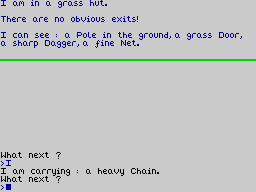
EYE OF BAIN
Artic / £6.95
Ross The task set in Artic's Eye of Bain is
to locate and hang on to a priceless
emerald. You
|
don't, however, start off in
the easiest of circumstances. At first you
seem to be in a hut, and typing 'Look' will
instigate the drawing of a full screen
picture of your surroundings. It's not until
you start to try and move around that
you're told a chain is clamped to your leg
- which in turn is attached to a pole. To
free yourself you have to type in two
absolutely correct words. This problem of
syntax and vocabulary is one that I find
very annoying with adventures in general
and Eye of Bain is no exception. For
example, words that are used to describe
objects at a location are not recognised if
you try to use them yourself.
All the locations I visited had an
associated picture and most had some
useful objects, or tasks that needed to be
performed. The top few lines of the screen
are devoted to describing the location ... its
exits and objects.
|
This is quite useful but
my more hardened adventuring friends
suggested that it detracted from the
atmosphere of the game.
A reasonable adventure, but I got stuck
because I hadn't quite
got the language right. 2/5 
Dave It took me about ten minutes to get
started and I'm nowhere near finished yet.
The game is interesting enough
for me to keep on trying. 3/5 
Roger Tarl the mighty warrior turned out
to be a bit of a wimp thanks to my erratic,
misspelt or incomplete commandments.
Adventurers should have patience with the
lame lexicon, though, because I haven't
declared the sacred emerald
on my tax return yet ... 3/5 
|
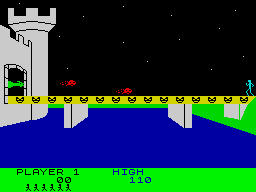
DRAGONFIRE
Cheetahsoft / £7.95
Roger Prefaced with barking hokum about
militant rebels and their house-trained
dragons depriving young Prince William
of his treasure,
|
this program is enough to
put even you off royalty for life.
Our regal hero begins his attempt at
regaining his birthright on the first screen
depicting the castle gates and drawbridge.
All the young lad has to do is nip across
quick, dodging the odd gob of lethal
dragon fire, to gain entry to the treasure.
So far, so good, and on to the second
screen, which has even cruder graphics.
The noble prince can be shuffled round
safely out of dragon-range and the
relevant goodies scooped up into His
Highness's Post Office account - or
wherever yer Royals keep their
negotiables. Prince and player should then
be trembling at the dire warning about
how hard life gets after the second level ...
Although there's a voluntary choice of
four difficulty levels, the game
automatically gets more serious with
success - but the grandiose let-down is
that there isn't anything past the
|
second
level. That's your lot, mate! It's back to the
first screen ... it just gets harder.
What we're actually looking at is a
stunning lack of program content and
detail. Boredom grows faster than skill
rating and, quite frankly, Dragonfire has
got about as much future as
the feudal system. 1/5 
Ross How they ever managed to write this
code in such a way that you need 48K to
run it, I'll never know. This is one that
wouldn't have been well
received two years ago! 0/5 
Dave A real contender for the Turkey of
the Year Award is this one, the graphics
are awful (the jumps are particularly
hilarious) and the game has
no real challenge to it. 0/5 
|
|
| JOYSTICK JURY
|
|
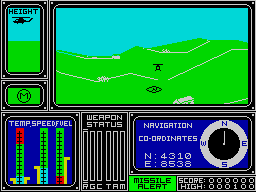
COMBAT LYNX
Durell Software / £8.95
|
Dave Combat Lynx is a battle simulation
program that has you flying your Lynx
helicopter around a three-dimensional
battlefield (which is randomly created for
each game); you have to perform the dual
function of destroying enemy forces and
supplying your bases.
Controlling your helicopter can be a bit
of a nightmare, because there are four
command modes and some keys are used
in more than one mode to perform
different functions. Even allowing for this,
there are nearly 30 control keys (most are
re-definable) although any keyboard
reading joystick can be used for five of
them.
The screen shows your flight
instruments and a rather peculiar view of
your helicopter. It's strange because,
although you can fly in any direction, the
view of the landscape is always
|
North,
South, East or West, with the helicopter
graphic turning through up to 45 degrees.
When you turn far enough, the screen
blacks out and re-draws with the
landscape turned through 90 degrees.
These factors neatly conspire to turn what
is basically a very good game
into a mess. 2/5 
Ross The representation of the hills and
valleys is well performed and
fast. 2/5 
Roger Sorry Colonel, but it ain't simulator
material for hackers with Falklands Factor
aspirations and it ain't simple enough for
all us conscientious objectors
still hiding in arcades. 2/5 
|
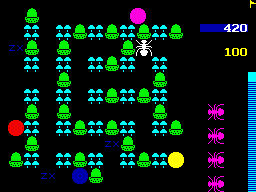
HYPERACTION
Silversoft / £5.95
|
Ross Silversoft's more recent output has
tended to be colourful, well written and fun
to play - and Hyperaction is no
exception. At first glance it seems a sort of
cross between Pacman and Pengo, but it's
actually different again. To begin with,
each screen cleared means another almost
totally different game, strategy-wise.
In screen one you're a spider in a maze
consisting of blocks of greenery separated
by patches of mushrooms. Also tucked up
inside the maze are four 'ZX' symbols and
the object is to collect all of them and
return pronto to the centre of the maze.
The only problem is that Pacmen also live
in said maze and if they touch you -
whoops, there goes another life. You can
push around the blocks of greenery to alter
the maze and block in the Pacmen - but
watch out!
|
The next game has you trying to destroy
all the blue maze pathways by walking
over them. The following screens are
variations that get increasingly more
difficult. I couldn't get past screen five,
where marauding 6502 chips soon
polished me off.
Good graphics and a fun game. Careful
thought is needed if you're
going to be good at it. 4/5 
Dave A nice Pengo variation with good
graphics. Possibly a bit too fast
but very addictive. 3/5 
Roger I'd like to say it only had one screen,
but that'd just be an excuse for my bad
play! Pure arcadia in the
best sense of the word. 3/5 
|
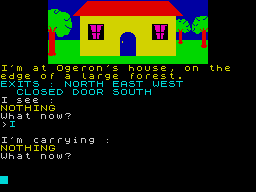
KENTILLA
Micromega / £6.95
Dave Kentilla is a text and graphics
adventure by Derek Brewster, and a
follow-up to his very
|
successful Velnor's Lair. The story follows on from the
previous adventure with 'baddie' Grako
taking over from Velnor; he's hungry for
the Moonstone of Algrath - the source of
Velnor's power. Mr Brewster writes an
adventure column for a certain Spectrum
games review magazine, where he gives
each adventure a rating under five
different headings. It seems fair, therefore
to rate his own adventure in the same way.
Atmosphere: The graphics are good but,
as Derek has himself said, most graphics
are no substitute for good text; his are no
exception.
Vocabulary: Kentilla has a very good
input editor which behaves rather like the
Basic line editor.
Logic: After some three hours of play I
was still stuck within a 10-location section
while trying everything I could think of to
progress. I must have missed something
but either it's
|
too obvious to notice (if so,
then apologies to Mr Brewster) or it's
completely illogical.
Debugging: Very good.
Overall: I'd have expected something
better from someone who
tells people what's wrong with
their adventures. 2/5 
Ross A reasonable enough adventure with
good edit and recall facilities. I didn't like
the way it lists out objects, exits and so on,
and the puzzles were a bit too
puzzling for me. 2/5 
Roger Is our hero's surname meant to be
Livingstone or do we need to move further
North and interpret this as a mystical
allegory on a quiet day at the National
Union of Miners? Did Grako cross picket
lines when he returned to
the abyss? Am I mad? 4/5 
|
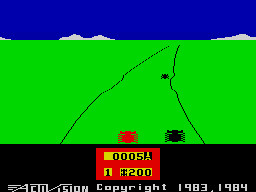
ENDURO
Activision / £7.99
Roger Although we're talking racing cars
here rather than motorbikes, the scenario
and
|
practical action of Enduro is very
similar to Micromega's Full Throttle. The
player uses a pair of keys to steer, and has
both throttle and brakes on the keyboard.
Joystick control is easier and obviously
more instinctive, with a simple pull-back
on the stick to hang out the anchors.
The challenge is to keep on going in any
weather or visibility condition, overtaking
the requisite number of other cars each
'day'. During the first cycle, 200 cars must
be passed and in subsequent 'days', the
opposition increases to 300. Apart from
'day' and 'night' driving conditions - only
tail lights are visible during the latter - ice
and fog also appear, demanding slower,
more careful and precise car control.
The essential similarities to Full Throttle
are tracking control and graphics, in as
much as the visuals are dominated by a
wiggling ribbon
|
representing the road,
tapering off to the horizon. I suppose it's
got the same ability to excite, amuse and
addict 'go-faster' merchants, but it ain't
sufficiently different to justify acquisition
if that other program's been LOADed in
the recent past.
To be honest, I got quickly tired of it,
but there again, I've been tired
all my life ... 3/5 
Ross Very similar to the VCS version. An
outdated game more like a
dodging blobs session. 1/5 
Dave The graphics are quite good. The cars
coming towards you are not exactly
perfect but they're reasonable and they
move fast. It seems quite easy to master
and will probably get tedious
once you get the hang of it. 3/5 
|
|
| JOYSTICK JURY
|
|
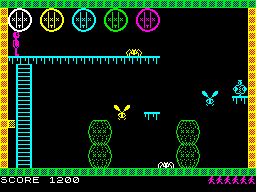
TROUBLE BREWIN'
Silversoft / £5.95
Roger Never mind Trouble Brewin', I had
|
trouble playing this game! Typically, most
of the aggro came from a complete lack of
instructions or explanations with the test
sample, which meant that I had to suss out
the required action on each of five screens.
Fortunately, a 'practice' facility accesses
any of the screens and erratic key-stroking
soon identified the point of it all.
Imagery is mostly concerned with
alcoholic beverages, a subject extremely
dear to my heart. Barrels, vats and glasses
of bubbly proliferate. In the first screen, a
deadly corkscrew is just one of the things
to be avoided and in the fifth, the
champagne realistically knocks you out -
well, it always makes me comatose!
Altogether, despite my 'orrible
suspicion of things arcade, I must say that
the game did
|
seem a bit - dare I say -
easy. The mobile nasties and fixed
obstacles are far too predictable and crude.
Maybe it'll be a big success with Real
Ale' freaks, but I think I'll
stick to lager. 2/5 
Ross Silversoft has come up with more
pretty graphics. It also seems to have the
knack of making the nasties just intelligent
enough to cause problems, but
not so you can't escape. 3/5 
Dave Just the job if you're looking for
another 'jumping around and collecting'
game. It has nicer graphics than most but
calls for arcade skill rather
than planning. 3/5 
|
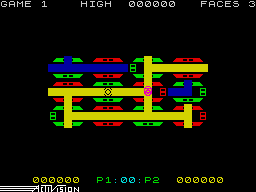
ZENJI
Activision / £7.99
Dave Zenji is the latest in a long line of
computerised puzzles and it comes
complete
|
with the obligatory mish-mash of
philosophical bits and pieces that are
traditionally used to jazz up this type of
program.
In order to achieve 'Zenji' you must
rotate the maze 'elements' (straight lines,
corner pieces and 'T' shapes) so that they
all join up with a particular element known
as the 'source'. Rotation is achieved by
moving your face-shaped player to the
centre of the element you wish to turn and
pressing a special key (or the joystick
button) along with a rotation key. In
normal use the rotation keys move you left
and right, with two more keys for up and
down. There's a time limit for the
completion of each maze (which get bigger
as the game progresses) and 'Flames of
Desire' appear which follow you around
and quite rightly provoke fatal
consequences if touched.
Zenji will appeal mostly to puzzle
enthusiasts
|
but on the higher levels it
becomes quite a test of arcade skill. As the
cassette sleeve says, you have to 'let go'
and leave your fingers to do
the work on their own. 3/5 
Ross Quite an intriguing little mind-twister
with reasonable graphics and easy-to
understand instructions. However, that's
not saying it's easy to play. If you like
'thinking' games, then this
could be worth a look. 2/5 
Roger The 'Flames Of Desire' are not a
threat I learned to fancy much but that's not
because I suffer 'illusions' ... Lust for
success and puzzling enlightenment failed
to overcome my lack of skill,
Oh Grey One ... 4/5 
|
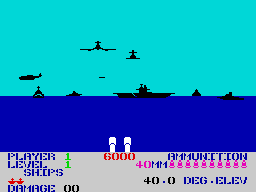
BEACH-HEAD
US Gold - Ocean / £7.95
Ross One of the Commodore 64
gamester's most popular releases, Beach-Head has now been implemented on the
48K Spectrum - courtesy of
|
the combined might of US Gold and Ocean.
Personally, I never found it that brilliant
on the 64, but certainly it's easily as good
on the Speccy.
Beach-Head is a multi-screened (six in
all) arcade/war game where the aim is to
penetrate the defensive power protecting a
piece of coastline, and capture the enemy
fortress. The first screen is a plan view of
the coast you're going to attack; you move
a cross (representing your fleet) through a
secret passage and into combat with the
opposing forces. The other five screens are
rather more lively. They involve steering
your ships through a barrage of torpedoes,
shooting down attacking planes, sinking
the enemy ships, guiding your tanks
through the shore defences and finally
blowing up the enemy's Big Gun.
This is definitely the best piece of code
ever
|
written by Ocean. It has good
instructions, comprehensive player and
control options and a good
range of skill levels 3/5 
Dave Ocean has done well in converting
this from the Commodore 64 version. The
game is very playable and the graphics are
good, especially the plane attack phase
Even so, it hasn't got very
much lasting appeal. 3/5 
Roger Not enough authentic strategy to
please committed wargames recruits and
not enough zap-splat-kapoww! to satisfy
the electronic bloodlust of trigger happy
arcade troopers. Nevertheless it's got
sufficient entertainment and
complexity value. 2/5 
|
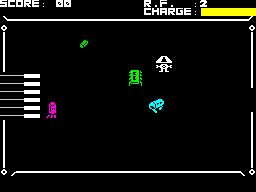
PSYTRAXX
The Edge / £7.95
Roger A sample tape with hardly any
instructions didn't increase the likelihood
of my establishing instant rapport with this
game. I'm
|
still not completely sure what
you're supposed to achieve and/or
whether there are hidden programming
secrets that incompetence and general lack
of Willis-interest failed to unlock.
If my eyes haven't deceived me - which
is always possible - the on-screen action
occurs on a circuit board and involves the
usual four-key control of movement plus
the ability to zap any opposition with what
one can only assume are graphic attempts
to represent electro-magnetic energy.
I would call it a one-screen stand even
though it's claimed to have over 1000! It's
not that other screens didn't exist, they're
just not that different. The graphics are
abysmal - unclear and unoriginal. The
screens seemed to suggest the programmer
had defined a few characters at the most,
and then used them around the edge.
If your vocabulary in Basic is even
smaller
|
than your basic vocabulary, then it
might just hold your interest for longer
than it did mine, but I doubt it. I'm afraid I
have to report that this is one of the most
boring and overrated games I've had the
misfortune to play since an old
school friend brought out
his conkers! 1/5 
Ross A competent piece of software but
rather dull in play and certainly not
original. If you like mapping
games, look no further. 3/5 
Dave Very like Atic Atac in approach but
with less interesting graphics. The Edge is
claiming a new programming technique
called Synergy allowing it to get over 1000
screens in 48K; Similar would probably be
a better name 'cos
that's what the
rooms are. 2/5 
|



















